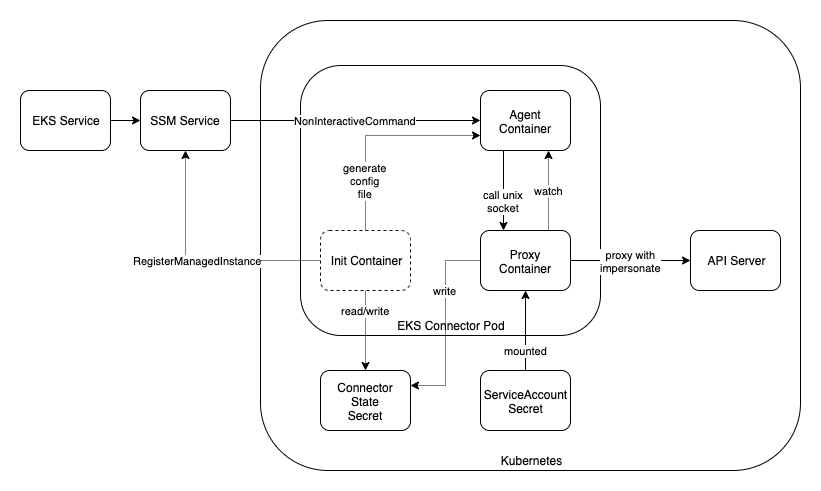EKS Connector
EKS Connector is a client-side agent that connects any Kubernetes cluster to AWS.
How it works
EKS Connector runs in Kubernetes as a Pod that consists of below containers:
init container
The init container is responsible for initiating the state of EKS Connector.
proxy container
The proxy container is responsible for proxying Kubernetes API Server traffic and applying appropriate user-impersonation flow.
agent container
The agent container runs the AWS System Manager Agent. It maintains a persistent, secure connection between the Kubernetes cluster and AWS.
AWS SSM agent is published at ECR Public
Development
Install from repo
Run the following command against the cluster after retrieving your activation code and id. See the guide here.
$ helm -n eks-connector install eks-connector \
oci://public.ecr.aws/eks-connector/eks-connector-chart \
--set eks.activationCode="<your-activation-code>" \
--set eks.activationId="<your-activation-id>" \
--set eks.agentRegion="<your-region>"Updating dependencies
GOPROXY=direct go get -t <module>go mod vendor- development with new dependency
go mod tidy- commit vendor folder changes in a dedicated CR for easier review
- commit code changes in follow-up CR
Release
Amazon EKS Connector build is released at ECR Public.
Test
To deploy it we need to create an SSM hybrid activation first. For testing, put a high number of activation instance so that we don't need to create activation often when SSM agent restarts.
# Fill in the activation ID and activation code.
export EKS_ACTIVATION_ID=""
export EKS_ACTIVATION_CODE=""
export EKS_AWS_REGION=""
# Replace with your custom built images if needed
export EKS_CONNECTOR_IMAGE="public.ecr.aws/eks-connector/eks-connector:0.0.3"
export SSM_AGENT_IMAGE="public.ecr.aws/amazon-ssm-agent/amazon-ssm-agent:3.1.1927.0"
# Apply the manifest
sed "s~%AWS_REGION%~$EKS_AWS_REGION~g; s~%EKS_CONNECTOR_IMAGE%~$EKS_CONNECTOR_IMAGE~g; s~%SSM_AGENT_IMAGE%~$SSM_AGENT_IMAGE~g; s~%EKS_ACTIVATION_ID%~$EKS_ACTIVATION_ID~g; s~%EKS_ACTIVATION_CODE%~$(echo -n $EKS_ACTIVATION_CODE | base64)~g" \
./manifests/eks-connector.yaml | kubectl apply -f -
# After a few seconds the connector pod should be healthy in kubernetes.
# Now get the managed instance at SSM.
aws ssm describe-instance-information --filters Key=ActivationIds,Values=$EKS_ACTIVATION_ID
# If you are lucky you should see exactly one managed instance.
# Alternatively, grep the logs at init container, which should print out the instance id.
# Now execute non interactive command
# NOTE: fill in TARGET with your own managed instance id like `mi-069f7e4b6ce64c0ce`
aws ssm start-session \
--target TARGET \
--document-name AWS-StartNonInteractiveCommand \
--parameters '{"command": ["curl --unix-socket /var/eks/shared/connector.sock -H \"x-aws-eks-identity-arn: arn:aws:iam::123456789012:user/test-user\" http://localhost/api/v1/pods"]}'Cleanup
Just delete with the manifest
sed "s~%AWS_REGION%~$EKS_AWS_REGION~g; s~%EKS_CONNECTOR_IMAGE%~$EKS_CONNECTOR_IMAGE~g; s~%SSM_AGENT_IMAGE%~$SSM_AGENT_IMAGE~g; s~%EKS_ACTIVATION_ID%~$EKS_ACTIVATION_ID~g; s~%EKS_ACTIVATION_CODE%~$(echo -n $EKS_ACTIVATION_CODE | base64)~g" \
./manifests/eks-connector.yaml | kubectl delete -f -Security
See CONTRIBUTING for more information.
License
This project is licensed under the Apache-2.0 License.
